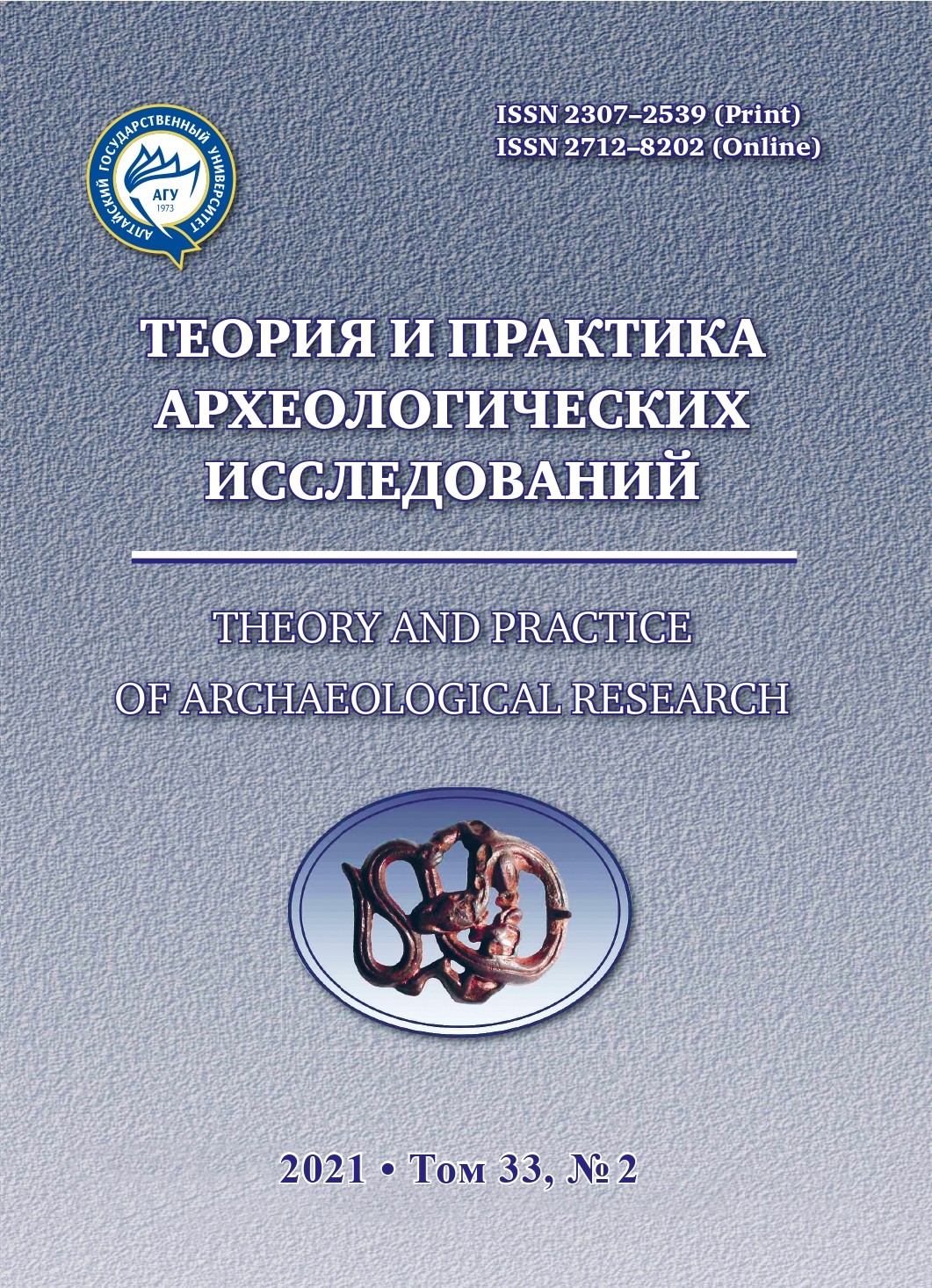CARTOGRAPHIC AND RELIEF ANALYSIS OF THE LOCATION OF THE MOUNDS OF THE LOWER DON
DOI:
https://doi.org/10.14258/tpai(2021)33(2).-01Keywords:
the Lower Don, burial mound, topography, relief, steppeAbstract
The regularities of the location of steppe mounds are currently poorly understood. The study is based on the inventory of the objects of the archaeological heritage of the Rostov region in the 1990s and 2008–2020. The presented developments were verified and refined by the excavations of several identified burial mounds. The paper presents the typology of the topographical position of burial mounds: floodplain, terraced, terraced-cape, slope, watershed. Five levels of analysis of the position of the mounds are proposed. The basic techniques of mound constructing are described, and the findings of the components of tools for digging the soil are presented. Three stages of the development of the burial mound are identified. Characteristics are given to natural, biogenic and anthropogenic forms of relief, which need to be distinguished from mounds. All this data is proposed to be used to search for mounds. To identify the mounds in the area, the key features of burial mounds are described. The hypothesis of the relationship between the type of topographical position and the right to use the territory is substantiated.
Downloads
References
Belinskij A. B., Fassbinder J., Rajnxol’d Pp. Zagadochnye drevnie kol’cevye sooruzheniya Severnogo Kavkaza i evropejskie paralleli [Mysterious Ancient Ring Structures of the Northern Caucasus and European Parallels]. Novejshie otkrytiya v arxeologii Severnogo Kavkaza: Issledovaniya i interpretacii [Krupnovsky Readings. Materials of the International Scientific Conference]. Maxachkala : Mavraev, 2012. Pp. 29–31. (In Russ.)
Bochkarev V. S., Rysin M. B. Prostranstvennyj analiz pamyatnikov arxeologii Nizhnego Povolzh’ya (po materialam pogrebenij eneolita — rannego zheleza) [Spatial Analysis of Monuments of Archaeology of the Lower Volga Region (Based on the Materials of Eneolite — Early Iron Burials)]. Arxeologiya Vostochno-Evropejskoj stepi [Archaeology of the East European Steppe]. Saratov: Izd-vo Saratovskogo nacional’nogo issledovatel’skogo gosudarstvennogo universiteta im. N. G. Chernyshevskogo, 2007. Vyp. 4. Pp. 58–69. (In Russ.)
Zabavin V. O. Topograficheskie i landshaftnye osobennosti razmeshcheniya kurganov srubnoj kul’tury Severnogo Priazov’ya [Topographic and Landscape Features of Placing Mounds of Srubnaya Culture of the Northern Azov Cegion]. Donec’kij arxeologіchnij zbіrnik [Donetsk Archaeological Collection]. 2012. № 16. Pp. 100–107. (In Russ.)
Kaurichev I. S., Panov N. P., Rozov N. N., Stratonovich M. V., Fokin A. D. Pochvovedenie [Edaphology]. M. : Agropromizdat, 1989. 719 s. (In Russ.)
Kovalevskij S. A. Osobennosti topograficheskogo raspolozheniya irmenskix mogil’nikov yuga Zapadnoj Sibiri [Features of the Topographic Location of Ilmen Burial Grounds in the South of Western Siberia]. Soxranenie i izuchenie kul’turnogo naslediya Altajskogo kraya [Preservation and Study of Cultural Heritage of the Altai Territory]. Barnaul : Izd-vo Alt. un-ta, 2013. Issue XVIII–XIX. Pp. 171–181. (In Russ.)
Kuznecov P. F. Osobennosti kurgannyx obryadov naseleniya Samarskoj doliny v pervoj polovine bronzovogo veka [Features of Kurgan Rites of the Population of the Samara Valley in the First Half of the Bronze Age]. Material’naya kul’tura naseleniya bassejna reki Samary v bronzovom veke [Material Culture of the Population of the Samara Basin River in the Bronze Age]. Samara : SamGPU, 2003. Pp. 43–51. (In Russ.)
Radovskij S. S., Seregin N. N. Topografiya i planigrafiya nekropolej bystryanskoj kul’tury Altaya skifo-sakskogo vremeni [Topography and Planigraphy of Necropolises of the Bystryansk Culture of the Altai Scythian-Saki Time]. Narody i religii Evrazii [Peoples and Religions of Eurasia]. 2019. № 4 (21). Pp. 17–33. (In Russ.)
Sapozhnikov I. V., Novickij E. Yu. Kurgany na beregax rek Yagorlyk i Trostyanec, opyt topograficheskogo analiza [Mounds on the Banks of the Yagorlyk and Trostyanets Rivers, Experience of Topographic Analysis]. Oxrannye istoriko-arxeologicheskie issledovaniya na Yugo-Zapade Ukrainy [Security Historical and Archaeological Research in the South-west of Ukraine]. Odessa; Zaporozh’e : Odesskij istoriko-kraevedcheskij muzej, 1990. Pp. 49–70. (In Russ.)
Smekalova T. N. Kurgany v landshafte Severnogo Prichernomor’ya. I. Predgornyj Krym [Mounds in the Landscape of the Northern Black Sea Region. I. Foothill Crimea]. Bosporskie issledovaniya [Bosporan Research]. 2009. Issue XXI. Pp. 42–119. (In Russ.)
Telegin A. N. Nekotorye osobennosti planigrafii kurgannoj gruppy Ob'ezdnoe-1 [Some Features of Planigraphy of the Embankment Group Obezdnoe-1]. Voprosy arxeologii i istorii Sibiri [Issue of Archaeology and History of Siberia]. Barnaul : BGPU, 2008. Pp. 37–46. (In Russ.)
Fajfert A. V. Topografiya, sposoby vozvedeniya i kolichestvennye xarakteristiki kurganov epoxi bronzy na territorii bassejnov Dona i Manycha [Topography, Methods of Construction and Quantitative Characteristics of Bronze Age Mounds on the Territory of the Don and Manych Basins]. Vestnik Kalmyckogo instituta gumanitarnyx issledovanij RAN [Bulletin of the Kalmyk Institute for Humanitarian Studies of the Russian Academy of Sciences]. 2015. № 1. Pp. 47–53. (In Russ.)
Chernyx L. A., Daragan M. N. Kurgany epoxi eneolita-bronzy mezhdurech’ya Bazavluka, Solenoj, Chertomlyka [Aeneolitic-bronze Age Hill Graves in the River Area Between Bazavluk, Solenaja and Certomlyk]. Kiev : Izdatel’ Oleg Filyuk, 2014. 568 s. (In Russ.)
Litvinenko O. R. Do vitokіv arxіtekturi dovgix mogil Nadchornomor’ya. Donec’kij arxeologіchnij zbіrnik. 2010. № 13/14. Pp. 30–66. (In Ukr.)


